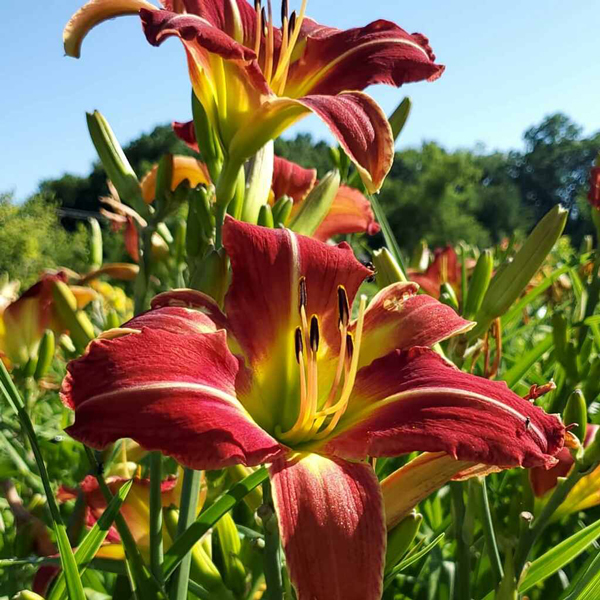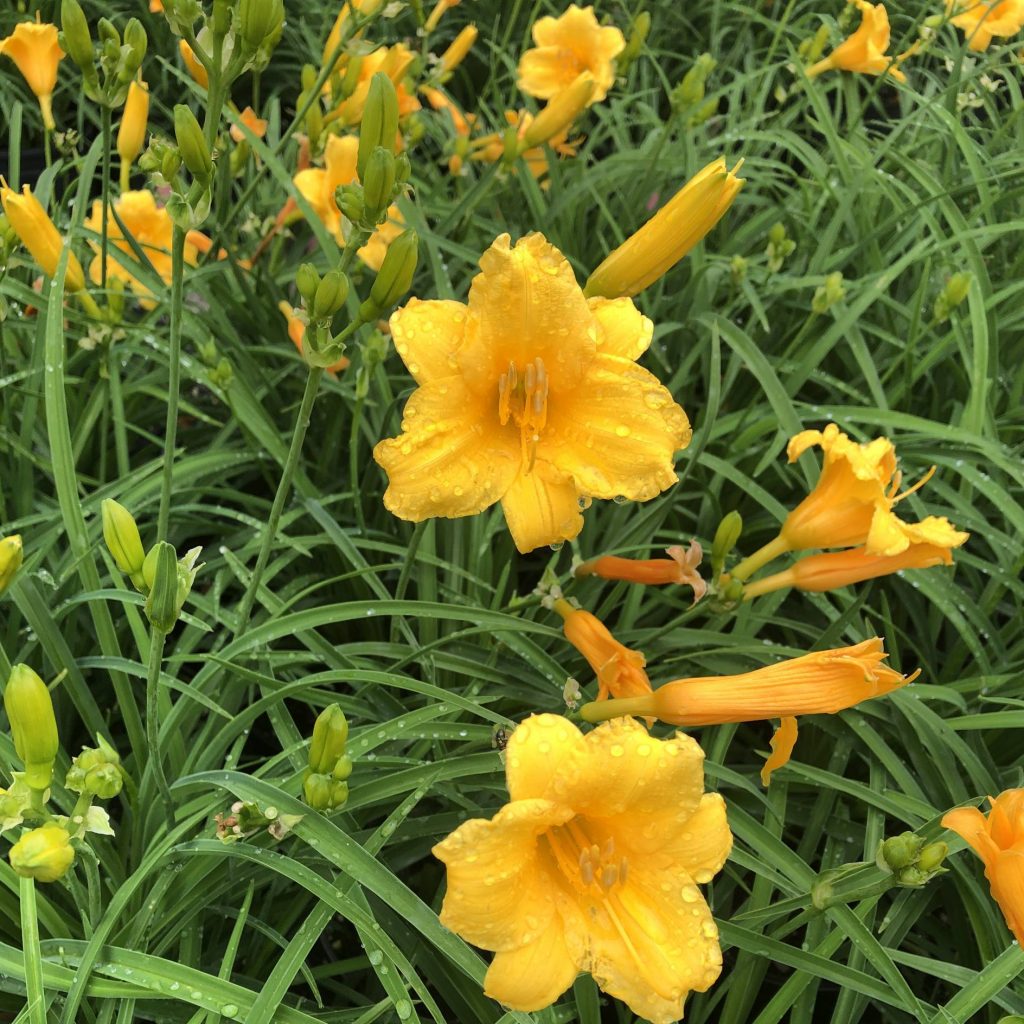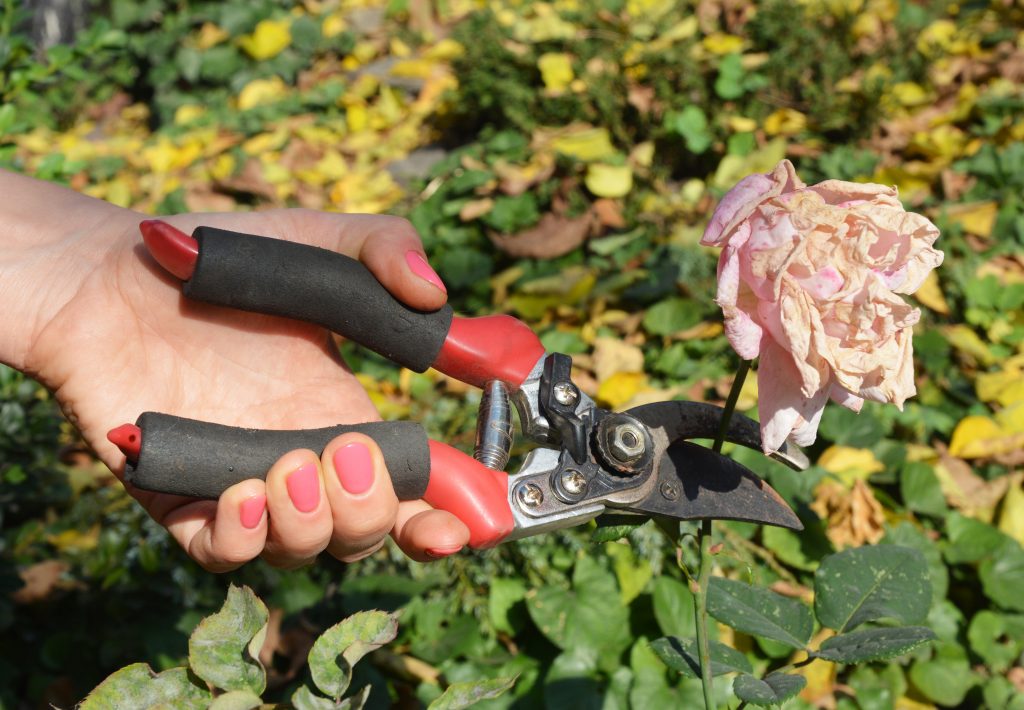
How to grow and care for these popular, low-maintenance perennials that thrive in sunny gardens.
By Linda Hagen
Daylilies are popular, easy-to-grow, low-maintenance perennials that are tough, long-lived, and tolerant of neglect. They bloom profusely, though individual blooms only last a single day and varieties number in the tens of thousands. Daylilies grow from fleshy roots, unlike true lilies that grow from bulbs.
Daylily Basics
Zones:
3-9, for most.
Height & spread:
Foliage clumps range from less than 1 foot to 3 feet tall. Flower scapes can be less than 1 foot to 6 feet tall, though most are 3 to 4 feet.
Exposure:
Full sun. They may tolerate some light shade; however, flowering is best in full sun.
When do daylilies bloom?
- Depending on the type, plants may begin blooming mid-spring, and some continue until fall.
- Individual blooms only last for a day, but multiple flowers on each stem bloom in succession, extending the overall bloom time for a single plant to about a month.
- Some varieties rebloom, such as Stella D’Oro, flowering several times throughout the season until fall.
Daylily colors & characteristics:
- Hybrids come in a rainbow of colors, including pale cream, shades of yellow, orange, red, pink and purple to almost black. The only colors not represented are true white and shades of blue.
- Flowers have 3 petals and 3 narrower petal-like sepals, and come in a variety of forms including single, double, spider, and star-shaped.
- Plants are classified by flower size (miniature, small, and large) and range from 3 to 15 inches across.
- Flowers bloom on leafless stems (scapes) that rise above long, narrow foliage. Mature plants can have several scapes, each with multiple flowers.
Toxicity:
Daylilies are toxic to cats, but not to dogs or humans. However, they may cause stomach upset to dogs if ingested. They look similar to true lilies which are extremely toxic to both dogs and cats. See more

How To Plant Daylilys
When to plant:
Container-grown or bareroot daylilies can be planted in spring or no later than 6 weeks before the first frost in autumn. In mild climates, they can be planted in summer. They’ll take about a year to establish themselves and then will spread quickly, forming dense clumps.
Where to plant:
For best blooming, plant in an area that will receive at least 6 hours of sun. They will tolerate poor soil quality, but not poor drainage, so make sure the site drains well. Daylilies are one of few plants that can be planted under black walnut trees because they are not affected by the chemical juglone that is leached into the soil by the tree.
How to plant:
When transplanting daylilies, either container-grown or bare-root, dig a hole deep enough so that the crown of the plant will be at the same height as originally grown. A band of white at the base of the foliage indicates what part was underground. A high-phosphorus fertilizer can be added to speed growth. Keep newly planted daylilies watered well. Mulch can be added to help hold in moisture.
Daylilies aren’t usually grown from seed by gardeners, as they rarely come true—meaning, have the same characteristics as the parent plant.
Day Lilly Care
Deadheading: Remove spent flowers regularly to keep them looking their best. To avoid seed pods from forming, make sure you are getting the entire flower and not just the petals. Deadheading is critical for subsequent flowering in reblooming types. Some say that because of the number of blooms they produce and the fact that they only last one day, deadheading can be a lot of work. (Note: Be careful with the darker purple varieties, they can stain your hands or clothes.)

Maintenance: Remove yellowed or dead foliage from the base by grasping firmly and giving a quick tug. After all blooming is done, plants can be sheared to the level of new growth or 6 to 8 inches from the ground and stems cut back to the base. Keep them watered well and you’ll get decent regrowth in 2 to 4 weeks. For reblooming types, simply removing dead or yellowed leaves is preferred over shearing because new flower stalks may be cut off. In mild climates, plants may remain semi-evergreen, and cutting back should be done in early spring before flower stalks appear.
Soil: Daylilies prefer moist, average to rich, well-drained soil. They will tolerate poor soil, but won’t tolerate poor drainage.
Amendments & fertilizer: Daylilies benefit from a balanced fertilizer and appreciate some extra nitrogen in the spring. Fertilizing once or twice during the growing season (spring) and once in fall will encourage strong growth, larger bloom size, and winter hardiness.
Watering: They will perform best with consistent watering—about 1 inch per day. It is important to water plants regularly in spring when scapes and buds are forming and also while blooming.
Dividing: Sparse flowering can be a sign of overcrowding. Dig up and divide clumps every 3 to 4 years, or every 2 years for reblooming types. Dig them up in early spring before blooming or late summer after blooming. Cut or pull the crowns apart carefully and replant.
Pests & diseases: Although seldom bothered by pests, aphids, spider mites or thrips may attack flower buds or foliage. Slugs and snails can also be attracted to tender foliage. If daylily rust (a fungus that damages foliage) is a problem, you may want to consult a local nursery for rust-resistant types to grow in your area.
Deer & rabbits: Daylilies are usually safe from rabbits. However, they are a favorite of deer, so set up deterrents if needed.
Design Tips
- Perfect choice for mass plantings, beds, borders, and meadow gardens.
- For beds or borders, use small-flowered minis at the front edge, large-flowered mid-height varieties in the middle, and long-stemmed spider types at the back.
- Small and mini varieties are well-suited for containers.
- Plant unusual, distinctive varieties up close where you can see them, on a porch or patio.
- Plant daylilies with other perennials, annuals, bulbs or shrubs like coneflower, iris, phlox, verbena, yarrow, Shasta daisy, black-eyed Susan, bee balm, or ‘Autumn Joy’ sedum.
- Use daylilies in cut flower arrangements. Individual flowers will only last a day, but buds along the scape will continue to open.
For more information on daylilies, check out the American Daylily Society at https://daylilies.org/







